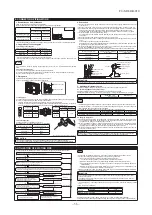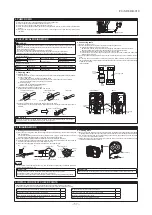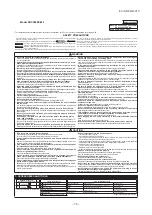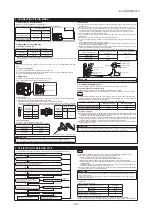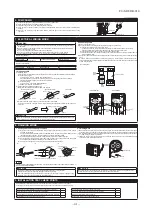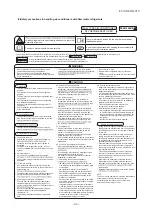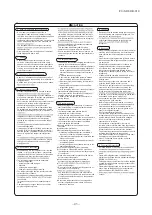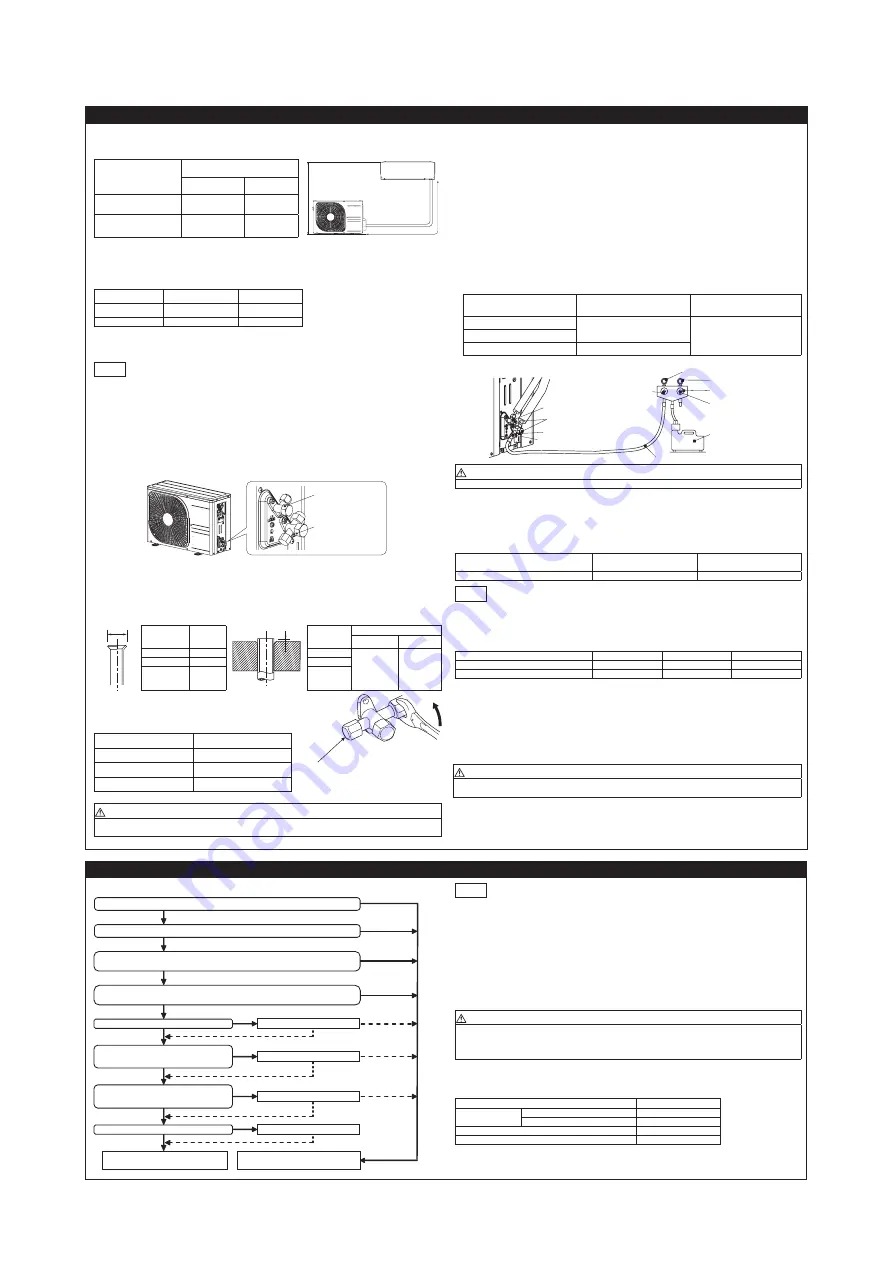
4. CONNECTING PIPING WORK
1. Restrictions on unit installation
Abide by the following restrictions on unit installation.
Improper installation can cause compressor failure or performance degradation.
Dimensional restrictions
H
L
Model SRC20/25/35
Model SRC50
Connecting pipe length(L)
20 m or less
25 m or less
Elevation difference between
indoor and outdoor units(H)*
10 m or less
15 m or less
* Outdoor unit installation position can be higher as well as lower than the indoor unit installation position.
2. Preparation of connecting pipe
2.1 Selecting connecting pipe
Select connecting pipe according to the following table.
Model SRC20/25/35
Model SRC50
Gas pipe
φ
9.52
φ
12.7
Liquid pipe
φ
6.35
φ
6.35
• Pipe wall thickness must be greater than or equal to 0.8 mm.
• Pipe material must be O-type (Phosphorus deoxidized seamless copper pipe ICS 23.040.15, ICS
77.150.30).
NOTE
If it is required to reuse the existing connecting pipe system, refer to 5. UTILIZATION OF EXISTING
PIPE.
2.2 Cutting connecting pipe
(1) Cut the connecting pipe to the required length with pipe cutter.
(2) Hold the pipe downward and remove the burrs. Make sure that no foreign material enters the pipe.
(3) Cover the connecting pipe ends with the tape.
3. Piping work
Check that both liquid and gas service valves are fully closed.
Carry out the piping work with service valves fully closed.
Liquid service valve
Gas service valve
3.1 Flaring pipe
(1)
Take out flare nuts from the service valves of outdoor unit and engage them onto connecting pipes.
(2)
Flare the pipes according to table and figure shown below.
Flare dimensions for R32 are different from those for conventional refrigerant.
Although it is recommended to use the flaring tools designed specifically for R32 or R410A, conventional
flaring tools can also be used by adjusting the dimension B with a flare adjustment gauge.
A
Copper pipe
outer diameter
A
B
Copper pipe
outer diameter
B [Rigid (clutch) type]
R32 or R410A Conventional
φ
6.35
9.1
φ
6.35
0-0.5
1.0-1.5
φ
9.52
13.2
φ
9.52
φ
12.7
16.6
φ
12.7
3.2 Connecting pipes
(1) Connect pipes on both liquid and gas sides.
(2) Tighten nuts to specified torque shown in the table below.
Service valve size (mm)
Tightening torque (N·m)
φ
6.35 (1/4")
14-18
φ
9.52 (3/8")
34-42
φ
12.7 (1/2")
49-61
Do not hold the valve cap area with a spanner
CAUTION
• Do not apply refrigerating machine oil to the flared surface. It can cause refrigerant leakage.
• Do not apply excess torque to the flared nuts. The flared nuts may crack resulting in refrigerant leakage.
4. Evacuation
(1) Connect vacuum pump to gauge manifold. Connect charge hose of gauge manifold to service port
of outdoor unit.
(2) Run the vacuum pump for at least one hour after the vacuum gauge shows -0.1 MPa (–76 cm Hg).
(3) Confirm that the vacuum gauge indicator does not rise even if the system is left for 15 minutes or more.
Vacuum gauge indicator will rise if the system has moisture left inside or has a leakage point.
Check the system for the leakage point. If leakage point is found, repair it and return to (1) again.
(4) Close the Handle Lo and stop the vacuum pump.
Keep this state for a few minutes to make sure that the compound pressure gauge pointer does not
swing back.
(5) Remove valve caps from liquid service valve and gas service valve.
(6) Turn the liquid service valve's rod 90 degree counterclockwise with a hexagonal wrench key to open
valve.
Close it after 5 seconds, and check for gas leakage.
Using soapy water, check for gas leakage from indoor unit's flare and outdoor unit's flare and valve rods.
Wipe off all the water after completing the check.
(7) Disconnect charging hose from gas service valve's service port and fully open liquid and gas service
valves. (Do not attempt to turn valve rod beyond its stop.)
(8) Tighten service valve caps and service port cap to the specified torque shown in the table below.
Service valve size (mm)
Service valve cap tightening
torque (N·m)
Service port cap tightening
torque (N·m)
φ
6.35 (1/4")
20-30
10-12
φ
9.52 (3/8")
φ
12.7 (1/2")
25-35
Charge hose
Handle Lo
Valve cap
Liquid service valve
Gas service valve
Service port
Compound pressure gauge
Pressure gauge
Gauge manifold
Handle Hi
Vacuum pump
CAUTION
To prevent vacuum pump oil from entering into the refrigerant system, use a counterflow prevention adapter.
5. Additional refrigerant charge
Additional refrigerant charge is required only when connecting pipe length exceeds A m.
5.1 Calculating additional refrigerant charge
Additional refrigerant charge can be calculated using the formula given below.
Additional refrigerant charge (g) = { Connecting pipe length (m) – Factory charged length A (m) } x 20 (g/m)
Model SRK, SRR
SRF35, FDTC
Model SRF25
A : Factory charged length (m)
15
10
NOTE
• If additional refrigerant charge calculation result is negative, there is no need to remove the refrigerant.
• If refrigerant recharge is required for the unit with connecting pipe length A m or shorter, charge the
factory charged amount as shown in the table below.
• The maximum refrigerant charge amount is designed as shown in the table below.
Model SRC20/25
Model SRC35
Model SRC50
The factory refrigerant charge amount(kg)
0.62
0.78
1.05
The maximum refrigerant charge amount(kg)
0.72 (SRF25: 0.82)
0.88
1.25
5.2 Charging refrigerant
(1) Charge the R32 refrigerant in liquid phase from service port with both liquid and gas service valves
shut. Since R32 refrigerant must be charged in the liquid phase, make sure that refrigerant is dis-
charged from the cylinder in the liquid phase all the time.
(2) When it is difficult to charge a required refrigerant amount, fully open both liquid and gas service
valves and charge refrigerant, while running the unit in the cooling mode. When refrigerant is
charged with the unit being run, complete the charge operation within 30 minutes.
(3) Write the additional refrigerant charge calculated from the connecting pipe length on the label at-
tached on the service cover.
CAUTION
•
Running the unit with an insufficient quantity of refrigerant for a long time can cause unit malfunction.
• Do not charge more than the maximum refrigerant amount. It can cause unit malfunction.
5. UTILIZATION OF EXISTING PIPE
(1) Check whether an existing pipe system is reusable or not by using the following flow chart.
Repair is impossible.
Air tightness is
impossible.
Repair is impossible.
Repair
Air tightness is OK.
Repair
Repair
NO
NO
NO
NO
NO
NO
NO
Are the outdoor and indoor units connected to the existing pipe system ?
Does the existing unit use any of the following refrigerant oils ?
Suniso, MS,Barell Freeze, HAB, Freol, ether oil, ester oil.
Do the existing pipe specifications (pipe length, pipe size and elevation difference between indoor and outdoor unit) conform to the restriction
of the unit.? (Go to 4.CONNECTING PIPING WORK and check 1.Restrictions on unit installation and 2.Preparation of connecting pipe.)
Is the existing pipe system free of gas leaks?
(Check whether refrigerant charge was required
frequently for the system before.)
Is the existing pipe system free of corrosion, flaws and dents?
Are heat insulation materials of the existing pipe system
free of peel-off or deterioration?
(Heat insulation is necessary for both gas and liquid pipes.)
Is the existing piping system free of any loose pipe support ?
The existing pipe system is reusable.
The existing pipe system is not reusable.
Install the new pipe system.
Repair the damaged parts.
Check the pipe system for air tightness.
Repair the damaged parts.
Repair the loose pipe support.
NO
Is it possible to run the unit ?
YES
YES
YES
YES
YES
YES
YES
YES
NOTE
• Consult with our distributor in the area, if you need to recover refrigerant and charge it again.
(2) Clean the existing pipe system according to the procedure given below.
(a) Carry out forced cooling operation of existing unit for 30 minutes.
For ‘Forced cooling operation’ refer to the indoor unit installation manual.
(b) Stop the indoor fan and carry out forced cooling operation for 3 minutes (Liquid return).
(c) Close the liquid service valve of the outdoor unit and carry out pump down operation (Refer to 6.
PUMP DOWN).
(d) Blow with nitrogen gas. If discolored refrigeration oil or any foreign matter is discharged by the
blow, wash the pipe system or install a new pipe system.
(3)
Remove the flare nuts from the existing pipe system. Go back to 4.CONNECTING PIPING WORK
and proceed to step 2.2 Cutting connecting pipe.
CAUTION
• Do not use the old flare nuts (of existing unit). Make sure that the flare nuts supplied with the (new)
outdoor unit are used.
• If the flared / compression connection to the indoor unit is located inside the house / room then this
pipework can’t be reused.
* If the existing piping is specified as liquid pipe ø9.52 or gas pipe ø12.7, refer to the following. (SRC50
only)
<Table of pipe size restrictions>
Additional charge amount per meter of pipe
0.054 kg/m
Pipe size
Liquid pipe
ø9.52
Gas pipe
ø12.7
Maximum one-way pipe length
10
Length covered without additional charge
5
Additional charge amount (kg) = {Main pipe length (m) - Length covered without additional
charge shown in the table (m)} X Additional charge amount per meter of pipe shown in the table (kg/m)
'20 • SRF-DB-310
-
36
-



